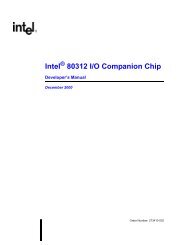Digital Subscriber Line Access Multiplexer (DSLAM) Example Design
Digital Subscriber Line Access Multiplexer (DSLAM) Example Design
Digital Subscriber Line Access Multiplexer (DSLAM) Example Design
Create successful ePaper yourself
Turn your PDF publications into a flip-book with our unique Google optimized e-Paper software.
<strong>Digital</strong> <strong>Subscriber</strong> <strong>Line</strong> <strong>Access</strong> <strong>Multiplexer</strong> (<strong>DSLAM</strong>) <strong>Example</strong> <strong>Design</strong><br />
Figure 13 shows how PDUs and flow control packets output from the Receive Processor to the<br />
IXB3208 are formatted. These PDUs and flow control packets are prepended with an inter-IXP<br />
header (containing classification information for traffic management), segmented, and then prepended<br />
with IXB3208 headers. (IXB3208 headers follow a standard format as specified in the<br />
IXB3208 documentation.) The input to the Transmit Processor is the same data with the IXB3208<br />
headers stripped off by the IXB3208.<br />
Figure 13. Receive Processor Output to IXB3208<br />
PDU or<br />
Flow Control<br />
Reassembled/modified PDU<br />
or Flow Control<br />
multiple of 48 bytes<br />
Classification Inter-IXP Header Reassembled/modified PDU<br />
or Flow Control<br />
SAR Sub-Layer<br />
(output from<br />
Processor A)<br />
Intel ®<br />
IXB3208<br />
Header<br />
Payload<br />
64 bytes<br />
Intel<br />
IXB3208<br />
Header<br />
Payload<br />
64 bytes<br />
Intel<br />
IXB3208<br />
Header<br />
Payload<br />
64 bytes<br />
A9556-01<br />
Figure 14 shows the format of the Inter-IXP header, which is used to communicate packet<br />
classification data from the Receive Processor to the Transmit Processor.<br />
Figure 14. Inter-IXP Header Format<br />
31 30 29 28 27 26 25 24 23 22 21 20 19 18 17 16 15 14 13 12 11 10 9 8 7 6 5 4 3 2 1 0 Offset<br />
Last Byte<br />
C A M Type CLP Priority Time Last Quadword in Packet<br />
in Packet<br />
0<br />
Source VC or Vport Destination VC or Multicast Group 1<br />
Legend<br />
C<br />
A<br />
M<br />
CLP<br />
Type<br />
Priority<br />
Time<br />
Last Quadword in<br />
Packet<br />
Last Byte in<br />
Packet<br />
Source VC or<br />
Vport<br />
Destination VC or<br />
Multicast Group<br />
Control Indicator<br />
0 = command packet<br />
1 = data packet<br />
ATM Indicator<br />
0 = unicast packet is not ATM<br />
1 = unicast packet is ATM<br />
Multicast Indicator<br />
0 = unicast packet<br />
1 = multicast packet<br />
Cell Loss Priority Indicator<br />
Connection Type<br />
1 =<br />
UBR<br />
2 =<br />
VBR<br />
4 =<br />
CBR<br />
The UBR Priority<br />
Time IXP1200 A spent on the packet in 1 microsec increments.<br />
The quadword offset from the start of the packet to the last quadword of data for the<br />
packet<br />
The last byte in packet is the number of valid bytes in the last quadword 1.<br />
These appear to be unique numbers per IP address.<br />
Application Note 27
















